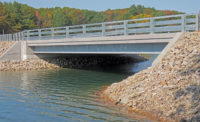
In just 10 weekends last summer, a joint- venture contractor demolished and replaced 14 bridges on I-93 north of Boston. Using conventional methods, the work could have taken four years.
The $98.1-million design-build project—called the "93 Fast 14"—was part of the Massachusetts Dept. of Transportation's Accelerated Bridge Program. The 2010 blowout of two bridge decks, which required emergency repairs and caused massive traffic delays, in Medford, Mass., provided an opportunity to test the program in the field.
"It was an unbelievably huge team effort. If one player didn't come through, it wouldn't have worked," says Bill Shea, project executive for J.F. White-Kiewit, a joint venture of J.F. White Contracting Co. and Kiewit Construction Corp., prime contractor for the project.
"Seven million dollars in incentives and disincentives were in play in equal amounts," adds Jack Harney, director of operations at J.F. White, Framingham, Mass. "We have earned $6.9 million in incentives to date and expect to get the $7 million by Nov. 15 when final paperwork is turned in." If the the four lanes of I-93 failed to open by 5 a.m. on any weekend, the JV would have lost $3.23 million for the first minute alone, he says.
All 14 bridge superstructures—seven in each direction—were replaced using prefabricated elements during June, July and August, with two weekends to spare and in time to avoid Hurricane Irene.
Harney says the team had design at 90% by Feb. 26 and started steel fabrication by March 1. On April 1, designs were sent to the precast shop for 257 precast modular units; on June 3, the first weekend of construction began.
After receiving a notice to proceed on Feb. 7, contractors had four months to prepare for fabrication all the bridge components, says Joe Gill, principal of Needham, Mass.-based Gill Engineering Associates, which designed eight of the 14 bridges. Dewberry, an engineering consultant in Fairfax, Va., designed four of the composite deck bridges, ranging in length from 240 ft to 350 ft. Lyn Associates, Brighton, Mass., designed two bridges. Gill says it helped to receive 25% plans from MassDOT "that were more advanced than 25%" and required only minor tweaking to proceed.
The aggressive, 60- to 80-hour-a-week schedule required some adjustments. "We didn't have the luxury of periodically cross-checking results of loads, distribution factors or elevation, so we had to pick off pieces of design and check calculations simultaneously to catch discrepancies early and not lose schedule before requesting a third-party check," says Gill.
For construction to proceed, the contract permitted closing a full six-mile section of I-93 in one direction for 55 hours over 12 summer weekends, says Mike McGrath, MassDOT deputy chief engineer of construction. For each weekend closure, this arrangement required I-93 to run two lanes each way in contra-flow fashion using existing barrier systems, with 22,000 ft of movable zipper barriers in between. "Eight lanes of highway were taken down to four lanes, with two lanes in each direction," McGrath says.
Rapid-Setting Mix
Meeting the 55-hour weekend schedule required use of a rapid-setting concrete mix for deck-closure pours, says Jim Cahill, project manager, J.F. White Contracting. After 42 concrete mixes were tested, the chosen proprietary mix achieved 2,000 psi in four hours after final set, which allowed traffic to return quickly. The team contacted engineering consultant CTL Group, which with Boston Sand & Gravel developed the high-performance mix with chemical admixtures, Cahill says. MassDOT allowed on-site testing by an independent lab.
Precast girders were delivered from Jersey Precast, Trenton, N.J., one week prior to setting, Gill says. "This required difficult logistical planning," he adds. The team used 120-ft-long movable dollies to move the precast units and called New York Gov. Andrew Cuomo's office for a police escort on the New York State Thruway. Due to the escorts availability, only three modules a day could be transported, with 252 permitted loads.
Following demolition that occurred from 10 p.m. to midnight, 24 to 36 precast panels per bridge were installed using 500- to 600-ton hydraulic cranes from Bay Crane, Harney says. Of the 300 crane lifts, 50 were critical due to hoisting 180,000 lb at a 70-ft radius, he says.





Post a comment to this article
Report Abusive Comment